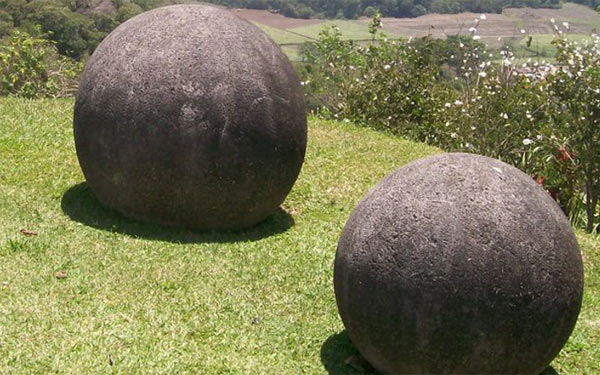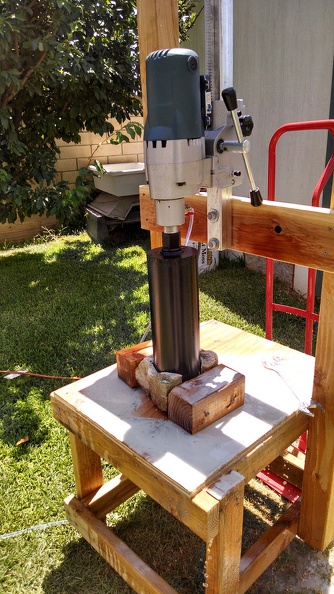|
|
Post by 1dave on Aug 24, 2017 6:47:54 GMT -5
All I'm saying is that without the hand held cup, the one head would never get the job done.
|
|
|
|
Post by Rockoonz on Aug 24, 2017 23:02:14 GMT -5
All I'm saying is that without the hand held cup, the one head would never get the job done. So you're saying the probably thousands of spheres made using the the single cup sphere setup for old flat laps don't exist? That's kind of like saying if I hold a lathe bit in my hand against my piece while the lathe bit in the tool post is cutting that the bit in my hand is somehow doing something important. On review it is clear that the upper "cup" is a measuring tool, and is doing ZERO material removal. |
|
|
|
Post by 1dave on Aug 25, 2017 0:13:09 GMT -5
All I'm saying is that without the hand held cup, the one head would never get the job done. So you're saying the probably thousands of spheres made using the the single cup sphere setup for old flat laps don't exist? That's kind of like saying if I hold a lathe bit in my hand against my piece while the lathe bit in the tool post is cutting that the bit in my hand is somehow doing something important. On review it is clear that the upper "cup" is a measuring tool, and is doing ZERO material removal. There have been spheres made with NO CUPS! I thought I said that making it perfectly round would be improbable without using the hand cup. I wonder how they made those nearly perfectly round huge spheres in Cost Rica?  en.wikipedia.org/wiki/Stone_spheres_of_Costa_Rica en.wikipedia.org/wiki/Stone_spheres_of_Costa_Rica |
|
Deleted
Deleted Member
Member since January 1970
Posts: 0
|
Post by Deleted on Aug 25, 2017 11:29:14 GMT -5
Tonight, I'm hoping tonight to make core cuts to make a preform. Will make images for this thread.
|
|
|
|
Post by 1dave on Aug 26, 2017 1:42:58 GMT -5
Rockoonz 's comments have me thinking along new (to me) lines. Any sized circle will fit comfortably anywhere on any sized sphere's surface.Why didn't that sink in to my brain sooner? All the cups on a sphere making machine DO NOT have to be the same size! Optimally the motion has to randomly spin the sphere around so all the high spots get ground down, sanded and polished. What is the best configuration of what sized cups to assure that happens? Does it make any difference if the cups are 1/4 or 1/3 or 1/8th new sphere diameter?
|
|
Deleted
Deleted Member
Member since January 1970
Posts: 0
|
Post by Deleted on Aug 26, 2017 10:48:19 GMT -5
Regarding cup size.
I have not experimented with different sizes but this concept intrigues me.
Today if my sphere is 5" the circumference is 15 so I use 4" cups leaving approximately 3/4" between each cup. Bigger cups won't fit and bang into each other too much smaller they cut slower and the rough ball pops out easier.
ETA
Might be smart to try a 3" cup in that trio. I can visualise better random motion.
|
|
Deleted
Deleted Member
Member since January 1970
Posts: 0
|
Post by Deleted on Aug 26, 2017 19:39:38 GMT -5
Core a boulder  Cut it cross wise  You make two round cuts and get a square  A third cross core still.leaves some corners  If this was agate or jasper I would finagle my jig to hold the stone again for a few more cuts. For marble or sandstone I'll just quickly take off the points in the supergrinder. Then straight to the sphere machine. 1davecaptbobAzRockGeek |
|
|
|
Post by 1dave on Aug 26, 2017 22:17:29 GMT -5
Excellent! Thank you Scott!
Your very brief stop just a tad north east of St. George Utah paid off in a future nice sphere.
And the price was right.
|
|
Deleted
Deleted Member
Member since January 1970
Posts: 0
|
Post by Deleted on Aug 27, 2017 12:40:49 GMT -5
Excellent! Thank you Scott! Your very brief stop just a tad north east of St. George Utah paid off in a future nice sphere. And the price was right. I have 11 more cores plus the remainder of this one. I will hand sand the cylinders and slice into coasters for Xmas presents. Thank you for the lead on the spot. Jeannie now and I wanna go back to see wonderstone, snowflake, Picasso again.... |
|
|
|
Post by 1dave on Aug 27, 2017 17:19:27 GMT -5
You might consider ALSO adding your images to the first post so the whole story is told in one place for new viewers.
|
|
juzwuz
has rocks in the head
  
Member since April 2010
Posts: 526
|
Post by juzwuz on Aug 28, 2017 15:27:20 GMT -5
I have an interest in spheres, but I'd have to buy way too much stuff to get started. I don't think my little ten inch saw would be much good for making spheres. The prices you listed for various machines don't include the cups, do they? It seems like that's another place that costs would reallly start to add up. I maxed out my ten inch saw when I made a 3.5 inch diameter sphere. I use cheap diamond core drill bits as grinding cups. Once they get worn down, I'm planning on finding someone who can braze on some diamond grinding segments. |
|
Deleted
Deleted Member
Member since January 1970
Posts: 0
|
Post by Deleted on Aug 28, 2017 15:44:32 GMT -5
I have an interest in spheres, but I'd have to buy way too much stuff to get started. I don't think my little ten inch saw would be much good for making spheres. The prices you listed for various machines don't include the cups, do they? It seems like that's another place that costs would reallly start to add up. Sorry Rob. I missed this. No, accessories not included |
|
|
|
Post by 1dave on Sept 7, 2017 6:37:42 GMT -5
I was running back through this and noticed you didn't mention your "Sphere Saw."  |
|
kevinh
off to a rocking start

Member since May 2015
Posts: 1 
|
Post by kevinh on Dec 1, 2017 17:43:39 GMT -5
All I'm saying is that without the hand held cup, the one head would never get the job done. So you're saying the probably thousands of spheres made using the the single cup sphere setup for old flat laps don't exist? That's kind of like saying if I hold a lathe bit in my hand against my piece while the lathe bit in the tool post is cutting that the bit in my hand is somehow doing something important. On review it is clear that the upper "cup" is a measuring tool, and is doing ZERO material removal. I think what 1dave is saying that without some other interaction, simply placing a preform on a single cup and spinning it, is going to do nothing but spin it like a top. You require a second interaction, hands or device to cause the off axis rotations needed to true a sphere. You notice in the video that the upper cup tilts back and forth to cause the sphere to rotate in different axis's. It is also used to apply weight to enhance the polishing action as can be seen when the optician adds a weight to it. Also there have been several "perfect" sphere's made over time for different purposes. In the video posted, they were making a kilogram reference using a single head at first (hands did the perturbations) and then a two head machine for polishing. However you want to define the role of the upper head, you can see him adding polishing compound so unless the upper cup is made from a perfectly frictionless material, they both have to contribute to the polishing action. Two four-head machines were built and used to make "perfect" spheres for the Gravity Probe B Experiment (GP-B) at Standiford. They had a peak to trough average of less than 25 nanometers. I'm just stating an opinion here, but I'd suppose a primary difference between 2-head and 3-head designs would be more support from more directions resulting in trapping the sphere better and reduced tendency to ejects a sphere (which happens). I would also imagine that 3-head would tend to average out errors better in the same way you use 3 flat laps against each other in turn to average out the errors in any one of them, 2 laps tend to mirror each other more. You can check that in any tool and die manuals. Yes, the more heads, the more cost and maintenance is true too, but you probably have to replace 2-heads slightly more often than 3-heads. For that matter, make a 6 head machine to capitalize on triangular stability, averaging, entrapment and speed. Kevin |
|
Deleted
Deleted Member
Member since January 1970
Posts: 0
|
Post by Deleted on Dec 1, 2017 20:04:10 GMT -5
For me the difference between 2 and 3 head machines are practical. Both produce a sphere so close to perfect we collectors don't know the difference. It's not measurable with standard calipers.
The practical difference is that three heads have more cutting surface so they cut faster. Also more cutting surface means less bouncing and the work piece is lost less often.
|
|
precisionrocks
off to a rocking start

Member since January 2018
Posts: 3 
|
Post by precisionrocks on Jan 13, 2018 23:32:04 GMT -5
One trick I have heard of for a jig for core drilling is to use a piece of pvc pipe cut in half legnth wise to hold your stone for the 2nd, 3rd, ect. Cuts. Your pipe I.D. would need to be the diameter of your core.
|
|
|
|
Post by toiv0 on Jan 14, 2018 5:25:04 GMT -5
@shotgunner What size sphere is the max where it doesn't make sense to use a core drill. If I use a three inch corer will that give me a three inch sphere? I just gave a core drill on a stand to my neighbor. Very heavy duty. Where does one get a reasonable core drill? Are they diamond or carbide?
|
|
Deleted
Deleted Member
Member since January 1970
Posts: 0
|
Post by Deleted on Jan 14, 2018 11:09:31 GMT -5
The bigger the better for coring. Up to the torque limits of the motor. Mine says up to 8" cores.
They are diamond.
As for ball size: it will be marginally smaller than the inside diameter of core bit.
|
|
Deleted
Deleted Member
Member since January 1970
Posts: 0
|
Post by Deleted on Jan 14, 2018 11:11:19 GMT -5
One trick I have heard of for a jig for core drilling is to use a piece of pvc pipe cut in half legnth wise to hold your stone for the 2nd, 3rd, ect. Cuts. Your pipe I.D. would need to be the diameter of your core. I just wedge mine between two hunks of 4*4 lumber that are deck screwed to the table. The core set tightly between. Works well. |
|
precisionrocks
off to a rocking start

Member since January 2018
Posts: 3 
|
Post by precisionrocks on Jan 14, 2018 23:20:32 GMT -5
I have the same question as toivO, where does one get a reasonably priced core drill and core drilling bits
|
|